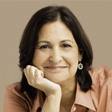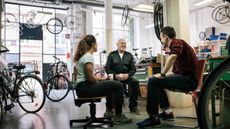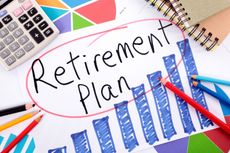Programs That Help Seniors and Children
Intergenerational residential communities can help seniors feel more productive and give children a strong sense of guidance.

In 2011, Laura Seeton received a call that upended her life, soon after graduating college at age 32. Her older sister, who had a drug addiction, had walked out on her children. The kids, ages 4, 5 and 9, spent six months in foster care while Seeton waited for her foster-parent certification. For three years, they lived in her two-bedroom home. “It was isolating and hard because I didn’t have support and felt that I couldn’t reach out to people,” says Seeton, now 35.
SEE ALSO:
QUIZ: Are You Saving Enough for Retirement?
p>

Sign up for Kiplinger’s Free E-Newsletters
Profit and prosper with the best of expert advice on investing, taxes, retirement, personal finance and more - straight to your e-mail.
Profit and prosper with the best of expert advice - straight to your e-mail.
Seeton found the support she needed from an older generation. In February 2015, she and the kids moved to Bridge Meadows, an intergenerational residential community in Portland, Ore. Its purpose: for adults ages 55 and older—called “elders”—to become an integral part of the lives of adoptive parents and their children, who had been in foster care. Bridge Meadows is home to 30 elders and 34 children and their mothers.
Elders volunteer an average of eight hours a week, in exchange for reduced rent for their apartment. The community eats together once a week. There are group activities as well as informal, day-to-day interactions. Professional therapists run support “circles” for seniors, adoptive parents and children. “We have no family to count on,” says Seeton. “At Bridge Meadows, there are handpicked elders who fill that role of Grandma and Grandpa and know these kids have trauma.”
Caryl Farrier, 73, has lived at Bridge Meadows since it opened five years ago. “The kids come in as scared little people and most are now confident,” she says. “They’re just fantastic.” The love flows both ways. “My own children know that I am taken care of,” Farrier says. “If I fell and broke a hip, all I would have to do is holler and someone would be there."
Intergenerational programs come in many forms, besides the Bridge Meadows residential model. For instance, at Providence Mount St. Vincent, a long-term-care facility in Seattle, a child care center is on the same floor as skilled nursing. Seniors read to kids, and make sandwiches with them for the homeless.
Schools are also getting into the act. Through the AARP Foundation’s Experience Corps, 3,000 adults ages 50 and older tutor students from kindergarten to third grade in 22 cities. In Swampscott, Mass., the high school and senior center share a building. The adults exercise in the gym, volunteer in the library and attend high school performances. Students have learned to knit and play bocce. Some seniors share their life stories as part of an oral history project with fourth-grade students at a nearby elementary school.
Intergenerational programs are proliferating along with the aging of the population and the growing recognition that “older-adult capital” has a lot to offer the younger generation, says Donna Butts, executive director of the nonprofit Generations United. The programs “allow young and old to be viewed as assets rather than as problems to be solved,” she says.
For seniors, mixed-age programs reduce loneliness and help them feel productive and valued. For children, the programs provide “opportunities to get to know older adults and counter the negative stereotypes society has of them,” says Shannon Jarrott, a professor of social work at Ohio State University.
Learning From Each Other
A number of adult day care programs are running intergenerational programs. St. Ann Center for Intergenerational Care, in Milwaukee, Wis., serves 95 young children who come after school or in the summer. It also serves 150 adults ages 21 to 100. Some are frail seniors who may use wheelchairs or walkers. And some clients have cognitive issues and benefit from socializing.
While each demographic group has its own space, a large glass-enclosed area in the middle hosts joint daily activities that include dancing and concerts. The older generation—called “adult friends”—may teach the youngsters about measurements while baking pies or discuss numbers while playing Bingo.
Sister Edna Lonergan, who is president, recalls watching a little girl sit down cautiously on the couch next to a senior. He tweaked her nose, and she tweaked his. Then she got a pillow, put it on his lap and lay her head down. “Sometimes you don’t have to have planned activities to form a connection,” Sister Edna says.
For Bianca Maki, 5, recent highlights include watching a Charlie Brown movie with the seniors and a toilet-paper snowball fight. “It was a blast,” says Ethel Ramirez, 88. “I love how the two-year-olds come through our room almost every day and how I can watch them when they’re in the next room,” she says. She recently helped a little boy frost cookies.
Audrey Pinney, 7, who has been attending the center since age two, says she loves “making my adult friends happy and having fun with them.”
One adult friend is Susan Gock, 64, a former toxicologist who had a brain aneurysm four years ago. “Having the kids around gives me a sense of purpose and keeps me positive,” says Gock. “I tell little girls they can go into science because I did. They sit in my lap, ask questions, and talk about school and their families.”
In Columbus, Ohio, a new intergenerational program is a laboratory for Ohio State University students who plan to pursue careers helping seniors or young children. Teams of students, doctors, social workers and nurses work with seniors from an adult day care center and children from an early-education program.
The goal of the Champion Intergenerational Enrichment and Education Center is to use intergenerational programming to help people of both demographic groups develop specific functional and social skills. For example, “the elder may find it more attractive to practice fine motor skills” in a program involving kids than with a staff member, says Jarrott, who is also an intergenerational consultant at Champion. And children can work on their own motor skills at the same time.
Each demographic group has its own part of the floor, with the intergenerational area in the middle. Activities include gardening, cooking and reading together. Both groups eat in the cafeteria together.
Willy Maynes, 63, who attends the adult care program, says he plays dominoes and other games with the children. “I like how they just talk to you, and it’s great to listen to the kids’ minds,” he says. “They always have something to say and it makes me feel good.”
To find programs near you, go to Generations United or Generations of Hope.
SEE ALSO:
10 Things You Must Know About Social Security
p>

-
 Strategies to Optimize Your Social Security Benefits
Strategies to Optimize Your Social Security BenefitsTo maximize what you can collect, it’s crucial to know when you can file, how delaying filing affects your checks and the income limit if you’re still working.
By Jason “JB” Beckett Published
-
 Don’t Forget to Update Beneficiaries After a Gray Divorce
Don’t Forget to Update Beneficiaries After a Gray DivorceSome states automatically revoke a former spouse as a beneficiary on some accounts. Waivers can be used, too. Best not to leave it up to your state, though.
By Andrew Hatherley, CDFA®, CRPC® Published
-
 403(b) Contribution Limits for 2024
403(b) Contribution Limits for 2024retirement plans Teachers and nonprofit workers can contribute more to a 403(b) retirement plan in 2024 than they could in 2023.
By Jackie Stewart Published
-
 SEP IRA Contribution Limits for 2024
SEP IRA Contribution Limits for 2024SEP IRA A good option for small business owners, SEP IRAs allow individual annual contributions of as much as $69,000 a year.
By Jackie Stewart Published
-
 Roth IRA Contribution Limits for 2024
Roth IRA Contribution Limits for 2024Roth IRAs Roth IRA contribution limits have gone up for 2024. Here's what you need to know.
By Jackie Stewart Published
-
 SIMPLE IRA Contribution Limits for 2024
SIMPLE IRA Contribution Limits for 2024simple IRA The maximum amount workers at small businesses can contribute to a SIMPLE IRA increased by $500 for 2024.
By Jackie Stewart Published
-
 457 Contribution Limits for 2024
457 Contribution Limits for 2024retirement plans State and local government workers can contribute more to their 457 plans in 2024 than in 2023.
By Jackie Stewart Published
-
 Roth 401(k) Contribution Limits for 2024
Roth 401(k) Contribution Limits for 2024retirement plans The Roth 401(k) contribution limit for 2024 is increasing, and workers who are 50 and older can save even more.
By Jackie Stewart Published
-
 Is a Medicare Advantage Plan Right for You?
Is a Medicare Advantage Plan Right for You?Medicare Advantage plans can provide additional benefits beneficiaries can't get through original Medicare for no or a low monthly premium. But there are downsides to this insurance too.
By Jackie Stewart Published
-
 What You Must Know About the Different Parts of Medicare
What You Must Know About the Different Parts of MedicareMedicare Medicare can be complicated but we've got you covered. Here is a quick guide to the different benefits provided through each part.
By Jackie Stewart Last updated